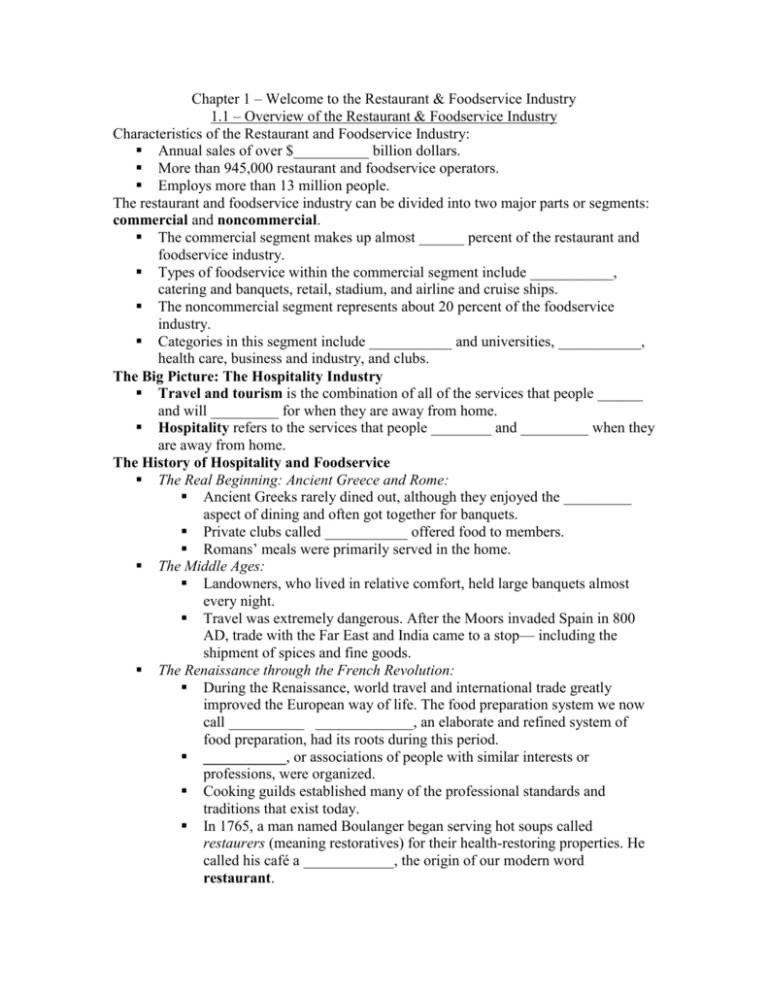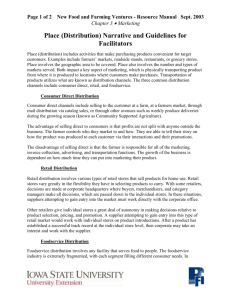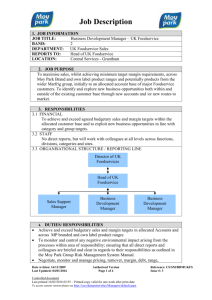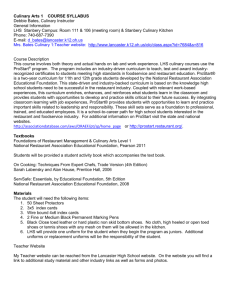Chapter 2 – Keeping Food Safe
advertisement

Chapter 1 – Welcome to the Restaurant & Foodservice Industry 1.1 – Overview of the Restaurant & Foodservice Industry Characteristics of the Restaurant and Foodservice Industry: Annual sales of over $__________ billion dollars. More than 945,000 restaurant and foodservice operators. Employs more than 13 million people. The restaurant and foodservice industry can be divided into two major parts or segments: commercial and noncommercial. The commercial segment makes up almost ______ percent of the restaurant and foodservice industry. Types of foodservice within the commercial segment include ___________, catering and banquets, retail, stadium, and airline and cruise ships. The noncommercial segment represents about 20 percent of the foodservice industry. Categories in this segment include ___________ and universities, ___________, health care, business and industry, and clubs. The Big Picture: The Hospitality Industry Travel and tourism is the combination of all of the services that people ______ and will _________ for when they are away from home. Hospitality refers to the services that people ________ and _________ when they are away from home. The History of Hospitality and Foodservice The Real Beginning: Ancient Greece and Rome: Ancient Greeks rarely dined out, although they enjoyed the _________ aspect of dining and often got together for banquets. Private clubs called ___________ offered food to members. Romans’ meals were primarily served in the home. The Middle Ages: Landowners, who lived in relative comfort, held large banquets almost every night. Travel was extremely dangerous. After the Moors invaded Spain in 800 AD, trade with the Far East and India came to a stop— including the shipment of spices and fine goods. The Renaissance through the French Revolution: During the Renaissance, world travel and international trade greatly improved the European way of life. The food preparation system we now call __________ _____________, an elaborate and refined system of food preparation, had its roots during this period. ___________, or associations of people with similar interests or professions, were organized. Cooking guilds established many of the professional standards and traditions that exist today. In 1765, a man named Boulanger began serving hot soups called restaurers (meaning restoratives) for their health-restoring properties. He called his café a ____________, the origin of our modern word restaurant. Colonial North America As people immigrated to the New World, cities along the East Coast grew. As early as 1634, an inn in Boston called Cole’s offered food and lodging to travelers. Very _________ early-colonial Americans ever traveled or ________ out. Those people who did travel, stayed at inns, often sleeping together in the same large room and even sharing a single bed. If travelers arrived after dinner had been served, they would have to go without. The Industrial Revolution: During the Industrial Revolution, people moved to the city to find work in the growing number of factories to earn a better living. People needed to live close enough to the factory to walk to work, go home for lunch, and leave again for dinner. As cities became business hubs, dining and lodging establishments opened up to serve the needs of workers and employers. With the invention of the _____________ in 1825, inns, taverns, and foodservice facilities located near railway stations began to grow. The Gilded Age: In the late nineteenth century, when high society dined out, they did so in style so that they could be seen in elegant surroundings. As a result of the California gold rush (1848–1855), people who hit the jackpot wanted to enjoy the fine dining that they knew existed in New York with their newfound wealth. For the thousands of less fortunate individuals, meeting the demand to feed them was nearly impossible. Clever restaurateurs developed the _______________, an assembly-line process of serving food quickly and cheaply without the need for servers. The Twentieth Century: By the turn of the century, more people were working and therefore eating out more, especially for lunch. During World War II in the 1940s, the lodging industry prospered as people traveled for war-related reasons. After World War II, in the 1940s and 1950s, the ____________ restaurant segment of the industry grew quickly. In the 1960s, commercial air travel became popular, and builders focused on land near airports as the next new place to situate hotels, motels, and foodservice facilities. 1.2 – Career Opportunities in the Industry Types of Establishments These types of business opportunities are available in restaurants. Corporate restaurant groups Chains ______________/franchisor Independents/entrepreneurs Catering provides opportunity for ____________ in menu selection and style of service. Caterers provide foodservice within: Hotels, ________________ catering companies, and restaurants. Events include: special events in private home, large-scale events (such as golf tournaments), ____________, and corporate dinners. Retail foodservice found in businesses that offer home meal replacements and readymade dishes. Examples: Bakery or deli in a grocery store Restaurant in a department store At stadiums or sports arenas, tens of ______________ of people with foodservice needs want service in a relatively ________ period of time. Stadiums also have corporate suites. Stadiums typically have contract feeders, a business who operates foodservice for a company. Convention centers are specifically designed to house large-scale special events such as conventions, expositions, and trade shows. A _______________ is a gathering of people, all of whom have something in common. Expositions are large shows, open to the ____________, that highlight a particular type of product or service. Examples: auto shows, garden shows While expositions are open to the general public, trade shows are ____________ to those involved in the industry being featured. Example: International hotel, motel, & restaurant show The _________ ___________ system is operated by the National Park Service, which is part of the U.S. Department of the Interior. In addition to parks, the national park system includes: recreation areas former battlefields other historic sites monuments memorials Modern theme parks offer a full array of _________________ features that create an overall atmosphere of fun. The popularity of theme parks as tourist destinations has had a major affect on all hospitality industries. In recent years, ______________ areas have also become a major destination for travelers in the United States and other countries. ______________ are typically either structures built to memorialize something or someone, or structures recognized for their historical significance. Concessions, restaurants within the monuments or associated with them, are common foodservice opportunities. _______________ offer a wide range of foodservice options, including concessions, fine dining, and casual dining. Foodservice in health-care facilities requires special attention to the ______________ needs of patients. Schools and universities often use satellite, or ___________________ feeding, which is when one kitchen prepares food that is then shipped to other locations to be served. Foodservice opportunities in the _______________ are greater now than ever. More than a million meals are prepared in military kitchens each day. Food is critical to maintaining a positive and peaceful atmosphere in correctional facilities. Well-prepared food at minimal cost is the challenge. There is a wide range of foodservice opportunities in the lodging industry—from luxury hotels with award-winning, fine-dining operations to discount chains offering breakfasts to travelers. Career Pathways Front-of-the-house employees serve guests ______________. These positions include managers, assistant managers, banquet managers, dining room managers, hosts/ hostesses, cashiers, bar staff, serving staff, and busers. Back-of-the-house employees work outside the public space. These positions include chefs, line cooks, pastry chefs, dishwashers, bookkeepers, storeroom clerks, purchasers, dietitians, and menu planners. An entry-level job is one that requires little or ____ ____________ __________. 1.3 – Overview of the Lodging Industry Why People Travel Leisure travelers go to a place for relaxation, _____________, education, adventure and sport, and social and family events. Business travelers go to a specific place for the purposes of sales, negotiations, ______________, or other types of business related to their jobs. Business travelers represent the majority of guests for most lodging establishments. To meet the needs of both leisure and business travelers, tourism is classified according to the type of travel experience that people desire including cultural, environmental, and recreational. Types of Lodging Operations Lodging properties are classified by the level of service provided, the rates charged, the amenities offered, or any combination of these or other factors. Luxury properties are hotels that offer top-of-the-line comfort and elegance. Full-service properties cater to travelers in search of a wide range of conveniences. Economy lodging offers clean, _______-priced lodging to traveling salespeople, senior citizens, and families with modest incomes. All-suite properties offer apartment-style facilities. Resorts feature extensive facilities for ____________ who are looking for recreational activities and entertainment. Bed and breakfasts cater to guests looking for quaint, quiet accommodations with simple amenities.










